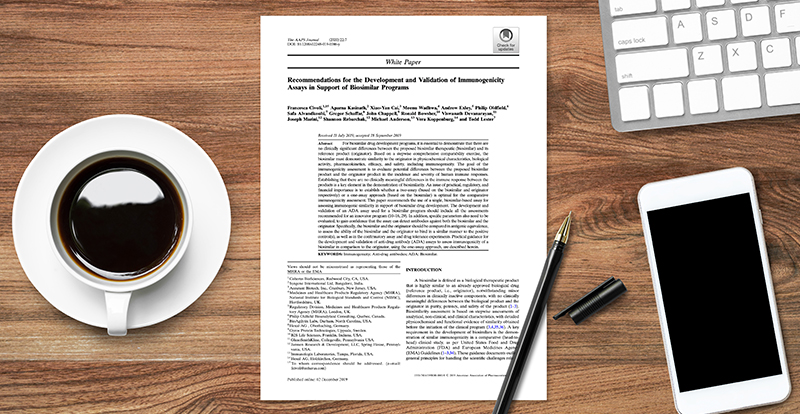A biosimilar therapeutic product is one that is highly similar to its reference product – an already-approved biological drug (the originator) – in that it has no clinically meaningful differences from the originator in terms of its purity, potency, and safety. The complexity of biological therapeutics presents a challenge in obtaining sufficiently comprehensive data to support biosimilarity assessment, and a multi-faceted approach to their bioanalysis is required.
The Evolving Field of Biosimilar Development
This is compounded by the fact that the field of biosimilar development is still evolving, and a lack of regulatory guidance on bioanalytical methods to support them still exists. But focus on biosimilar development is also growing, and the industry as a whole has continued to gain more biosimilar-specific experience in areas such as non-clinical and clinical assay development and validation, PK/PD considerations, and immunogenicity testing. Over time, best practices have emerged, and we are beginning to see a convergence in thinking around bioanalytical strategies supporting biosimilar development programs.
One organization that has been spearheading this global consensus-building effort is the American Association of Pharmaceutical Scientists (AAPS). An AAPS working group recently released the third white paper in a series on bioanalytical strategies to support biosimilar programs. Taken together, these white papers represent the culmination of years of discussions across the industry and with regulators to create consensus recommendations that will hopefully help shape future regulatory guidelines.
BioAgilytix has been fortunate enough to have several of its team members participate as co-authors on all three of these AAPS white papers, which have had and will continue to play an influential role in shaping the evolving biosimilar development landscape.
2014: A Single Ligand-Binding Assay to Support Pharmacokinetic Assessments
The first AAPS white paper, released in 2014, provides recommendations for the development and validation of a single ligand-binding assay (LBA) to support pharmacokinetics (PK) assessments for biosimilar drug development. Under the AAPS Ligand-Binding Assay Bioanalytical Focus Group (LBABFG)’s Biosimilars Action Program Committee (APC), which was formed in response to a lack of specific regulatory guidance around the requirements for the bioanalytical testing of biosimilars and reference biological products, the paper was developed in an effort to harmonize global biosimilar PK assay practices across the scientific community and regulatory authorities.
Why It Was Pivotal:
This paper established industry consensus to quantify both biosimilar and originator compounds equally using a single LBA. During method development, the standard curve generated using the biosimilar drug should be bioanalytically similar to a standard curve generated using the reference drug. During validation, the drug concentrations of QC samples spiked with the biosimilar should be bioanalytically similar to those spiked with the originator.
2017: Establishing Best Practice Approaches for Neutralizing Antibody Assays
The second white paper from the AAPS working group was published in 2017 and provides recommendations for the development and validation of neutralizing antibody (NAb) assays in support of biosimilar assessment. Key to confirming biosimilarity is demonstrating no clinically meaningful differences in immune response between a biosimilar and its reference product, and therefore it is critical to collect, evaluate, and compare safety and immunogenicity data – especially when the originator drug product is known to have the potential for immune-mediated toxicity. This paper provides consensus recommendations to industry on best practices related to NAb assay formats, critical reagents, approaches to method development, and validation of NAb assays to support biosimilar drug development programs.
Why It Was Pivotal:
At the time this paper was released, there were still differing opinions throughout the industry on the best approach for biosimilar immunogenicity assays: whether to use a one-assay approach with biosimilar reagents, or a two-assay approach in which each assay is optimized for the respective drug. The AAPS set forth its recommendation to use a one-assay approach whenever feasible, as it reduces inter-assay variability, streamlines data interpretation for the comparability assessment, and eliminates operational challenges associated with bioanalytical analysis to support blinded head-to-head clinical studies. The recommendations outlined in this paper are still impacting the industry today.
2019: Forming Consensus for the One-Assay Approach to Immunogenicity Assays
I myself had the privilege to contribute to the most recent AAPS white paper in the series which provides recommendations for the development and validation of immunogenicity assays in support of biosimilar programs. It provides insight from both the scientific community and regulators into the merits of the one-assay versus two-assays approach, and it sets forth the adoption of the one-assay approach as the default strategy for harmonizing the design and implementation of ADA assays supporting biosimilar drug development.
Why It Is Pivotal:
This paper included significant contributions from both US- and European-based regulators and authoritatively establishes a consensus recommendation to use a one-assay approach for the development and validation of ADA assays supporting biosimilar programs based on its major advantages: uniformity, reduction of assay bias, streamlining conduct of validation, and operational simplicity in supporting the unequivocal clinical determination of the similar immunogenicity of a candidate biosimilar compared to the originator.
Together the white papers reflect the collective opinions on bioanalytical best practices of the industry at large to support biosimilar programs. Thanks to these efforts, sponsors, and CROs now have more clarity on the most effective approaches to accelerate biosimilars through the drug development process and to market to help patients in need. The BioAgilytix team is extremely proud to be a part of these collaborations and to share our expertise to help shape bioanalytical strategies that will optimize the outcomes of future biosimilar programs.
—
If you are ready to partner with industry-leading experts for your next biosimilars project, speak to one of our BioAgilytix scientists about your assay needs today. Interested in learning more about why the new AAPS white paper recommends the use of a single, biosimilar-based assay for assessing immunogenic similarity in support of biosimilar drug development? Join me for a webinar on January 23, 2020 in which we’ll take a deeper look into the paper. Register today!
